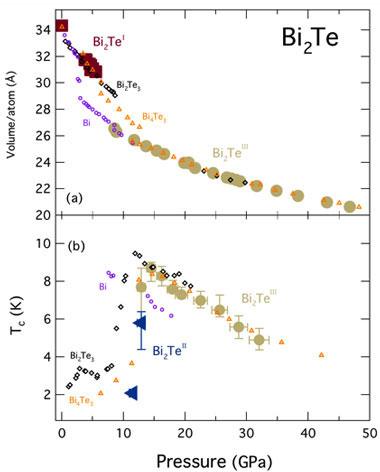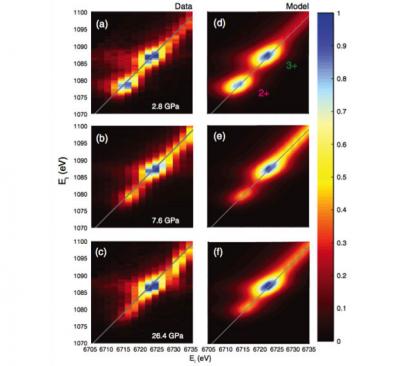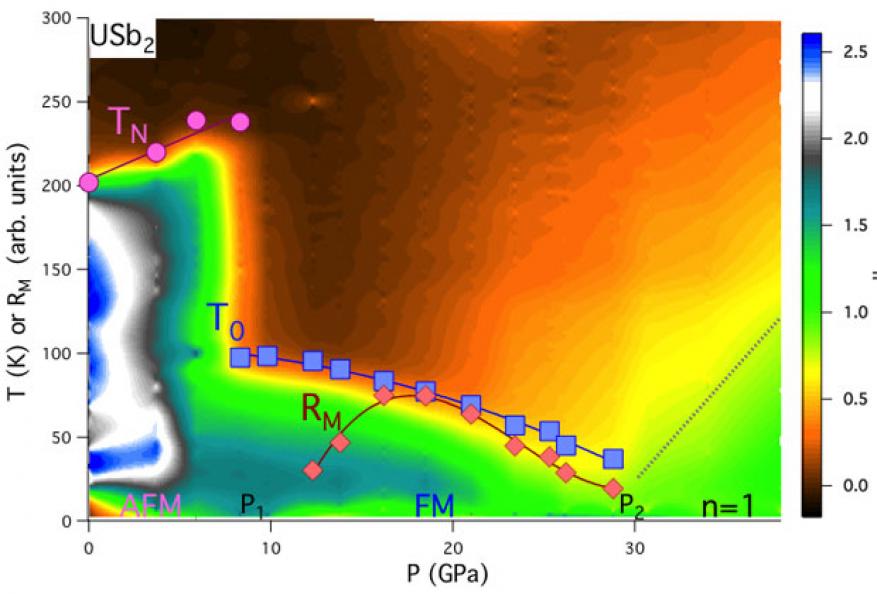Jason Jeffries (14-ERD-041)
Abstract
Quantum mechanical perturbations can affect applications ranging from permanent magnets to nuclear fuel forms to quantum computing, and they can drastically alter the formation energies and phase stability of actinide alloys. With this project, we proposed an experimental program combining sample synthesis and characterization, as well as high-pressure and chemical tuning. This research focused on select 4f-shell and 5f-shell electron systems where the electronic structure manifests topologically protected surface states, valence-induced emergent magnetism, and magneto-structural volume collapse. The measurements could provide valuable benchmarks of the structure–property relationships in actinide systems, which can be simulated using state-of-the-art theories under development at Lawrence Livermore. Employing an experimental suite of tools including sample synthesis, pressure tuning, and synchrotron-based characterization, we have examined a range of quantum materials. We have discovered superconductivity in the nominal semi-metal dibismuth telluride, established a pressure-resistant intermediate valence state in samarium hexaboride, and revealed emergent ferromagnetism in uranium diantimonide. These measurements have highlighted the power of pressure as a tuning parameter for quantum materials, and have established new phenomena that can serve as benchmarks for future model development.
Background and Research Objectives
Quantum materials occupy a position at the leading edge of research in condensed-matter physics and offer tantalizing prospects for next-generation applications owing to the appearance of exotic phenomena like unconventional high-temperature superconductivity, charge–density modulations, and topologically protected surface states. Harnessing these technological advantages is hampered by an incomplete understanding of their genesis, which ultimately arises from multiple quantum mechanical effects: the spin–orbit interaction and strong electronic correlations being the most prevalent examples.1,2 In order to begin to address these quantum corrections, we embarked on a comprehensive experimental program combining sample synthesis, characterization, as well as high-pressure and chemical tuning. This project aimed to investigate the limits and response to pressure of weakly correlated topological insulators, the pressure-dependent valence configuration of the Kondo insulator samarium hexaboride (SmB6), and the magneto-structural stability of uranium compounds.
Scientific Approach and Accomplishments
Superconductivity in a Strong Spin–Orbit Semimetal
One of our aims was to investigate properties driven by strong spin–orbit interactions in which the heavy nucleus must be included when considering the energy landscape. The material that we chose to study was dibismuth telluride (Bi2Te), a layered bismuth–telluride compound in a family whose end members can be tuned to superconductivity or topological insulators with chemical or applied pressure. The key to harnessing many of the macroscopic properties of technologically relevant materials is an understanding of the underlying quantum mechanical effects that drive those properties. We used high pressure to tune the interaction and correlation strengths within Bi2Te and used x-ray diffraction and magneto-transport measurements to study structure–property relationships.
Synchrotron x-ray diffraction measurements showed that Bi2Te progresses through three structural phases under the application of high pressure, eventually settling into a high-pressure, body-centered cubic phase. This high-pressure phase is universal across the entire (Bi2)m(Bi2Te3)n series, even collapsing into the same equation-of-state curve above 15 GPa, shown in Figure 1(a).
Pressure-Resistant Intermediate Valence in Samarium Hexaboride
Multi-configurational electronic states, or intermediate valence, are a hallmark of correlated electron physics. They can arise through direct hybridization between inter-atom states, but they can also arise from on-atom effects like the Kondo effect that occurs in the Kondo insulator SmB6. We have established that the intermediate valence state of this insulator persists under pressure. This compound exhibits an insulator–metal transition as well as the onset of magnetic order in the vicinity of 10 GPa. A long-standing analogy with a similar compound, samarium sulfide, assumed that the metallization and appearance of magnetism were signals of the collapse of the intermediate valence state into an integer valence (3+) state. Now, using resonant x-ray emission spectroscopy in a diamond anvil cell at the Advanced Photon Source (16 ID-D) at Argonne National Laboratory, we have unambiguously shown the persistence of a divalent signature alongside a tri-valence signature, a hallmark of the intermediate valence state (Figure 2). This implies that the band structure and magnetic order evolve unlike analogous systems, requiring new theoretical frameworks to describe this behavior.4Pressure-Induced Emergent Ferromagnetism from a Uranium-Based Antiferromagnet
Uranium diantimonide (USb2) is a correlated, moderately heavy-electron compound within the uranium dipnictide (UX2) series. It is antiferromagnetic with a relatively high transition temperature of 204 K and a large uranium–uranium separation. While the uranium atoms in the lighter dipnictides are considered to be localized, those of USb2 exhibit hybridization and itineracy, promoting uncertainty as to the continuity of the magnetic order within the UX2. We have explored the evolution of the magnetic order by employing magneto-transport measurements as a function of pressure and temperature. We find that the transition temperature in USb2 is enhanced, moving towards that of its smaller sibling uranium diarsenide (UAs2). But long before reaching a transition temperature as high as UAs2, the antiferromagnetism of USb2 is abruptly destroyed (Figure 3) in favor of another magnetic ground state. We identify this pressure-induced ground state as being ferromagnetic based on the appearance of a strong anomalous Hall effect in the transverse resistance in the magnetic field, a novel method that we have employed in the study of magnetic instability under pressure. With pressure, this emergent ferromagnetic state is suppressed and ultimately destroyed in favor of a non-Fermi-liquid ground state.5
Impact on Mission
Our research will translate into benchmarks for predictive capabilities in actinide systems in support of LLNL's core competency in advanced materials and manufacturing, with ramifications for stockpile stewardship and weapons program activities relevant to the central Laboratory mission in national security. We have established a robust sample synthesis capability, especially as it relates to uranium-based compounds. This capability is currently being exploited by multiple programs at Lawrence Livermore. In addition to the sample synthesis, we have established novel methods to interrogate strongly correlated systems under pressure, which will provide benchmarks for future theoretical efforts aimed at improving predictive capabilities for strongly correlated systems.
Conclusion
We investigated numerous high-pressure phenomena related to quantum materials. Employing sample synthesis, pressure tuning, and synchrotron-based characterization, we have examined a range of quantum materials. We discovered superconductivity in the nominal semimetal dibismuth telluride, established a pressure-resistant intermediate valence state in samarium hexaboride, and revealed emergent ferromagnetism in uranium diantimonide. Our measurements have highlighted the power of pressure as a tuning parameter for quantum materials, and have established new phenomena that can serve as benchmarks for future model development. This research has supported several programs at Lawrence Livermore, and has the potential to be extended to DOE Office of Science Basic Energy Sciences programs.
References
- Kotliar, G., et al., "Electronic structure calculations with dynamical mean-field theory." Rev. Mod. Phys. 78, 865 (2006).
- Pesin, D., and L. Balents, "Mott physics and band topology in materials with strong spin–orbit interaction." Nat. Phys. 6, 376 (2010).
- Stillwell, R. L., et al.,"Superconducting Bi2Te: Pressure-induced universality in the (Bi2)m(Bi2Te3)n series." Phys. Rev. B 93, 094511 (2016).
- Butch, N. P., et al., "Pressure-resistant intermediate valence in the Kondo insulator SmB6." Phys. Rev. Lett. 116, 156401 (2016).
- Jeffries, J. R., et al.,"Emergent ferromagnetism and T-linear scattering in USb2 at high pressure." Phys. Rev. B 93, 184406 (2016).
Publications and Presentations
- Butch, N. P., et al., “Symmetry and correlations underlying hidden order in URu2Si2.” Phys. Rev. B 91, 035128 (2015). LLNL-JRNL-654108. http://dx.doi.org/10.1103/PhysRevB.91.035128
- Chodash, P. A., et al., "Nuclear excitation by electronic transition of U-235." Phys. Rev. C 93, 034610 (2016). LLNL-JRNL-680284. http://dx.doi.org/10.1103/PhysRevC.93.034610
- Crowhurst, J. C., et al., "A combined theoretical and experimental investigation of uranium dioxide under high static pressure." J. Phys. Condens. Mat. 27, 265401 (2015). LLNL-JRNL-637734. http://dx.doi.org/10.1088/0953-8984/27/26/265401
- Jeffries, J. R., et al., "Emergent ferromagnetism and T-linear scattering in USb2 at high pressure." Phys. Rev. B 93, 184406 (2016). LLNL-JRNL-681439. http://dx.doi.org/10.1103/PhysRevB.93.184406
- Jeffries, J. R., et al., “Persistent Fe moments in the normal-state collapsed-tetragonal phase of the pressure-induced superconductor Ca0.67Sr0.33Fe2As2.” Phys. Rev. B 90, 144506 (2014). LLNL-JRNL-645206. http://dx.doi.org/10.1103/PhysRevB.90.144506
- Jeffries, J., et al., “Pressure evolution of electrical transport in the 3D topological insulator (Bi,Sb)2(Se,Te)3.” J. Phys. Conf. 592(1), 012124 (2015). LLNL-PROC-663727. http://dx.doi.org/10.1088/1742-6596/592/1/012124
- Nakajima, Y., et al., “High-temperature superconductivity stabilized by electron-hole interband coupling in collapsed tetragonal phase of KFe2As2 under high pressure.” Phys. Rev. B 91, 060508(R) (2015). LLNL-JRNL-667980. http://dx.doi.org/10.1103/PhysRevB.91.060508
- Lipp, M. J., et al., "Comparison of the high-pressure behavior of the cerium oxides Ce2O3 and CeO2." Phys. Rev. B 93, 064106 (2016). LLNL-JRNL-675872. http://dx.doi.org/10.1103/PhysRevB.93.064106
- Stillwell, R. L., et al., "Strongly coupled electronic, magnetic, and lattice degrees of freedom in LaCo5 under pressure." Phys. Rev. B 92, 174421 (2015). LLNL-JRNL-672877. http://dx.doi.org/10.1103/PhysRevB.92.174421
- Stillwell, R. L., et al., "Superconducting Bi2Te: Pressure-induced universality in the (Bi2)m(Bi2Te3)n series." Phys. Rev. B 93, 094511 (2016). LLNL-JRNL-679788. http://dx.doi.org/10.1103/PhysRevB.93.094511








